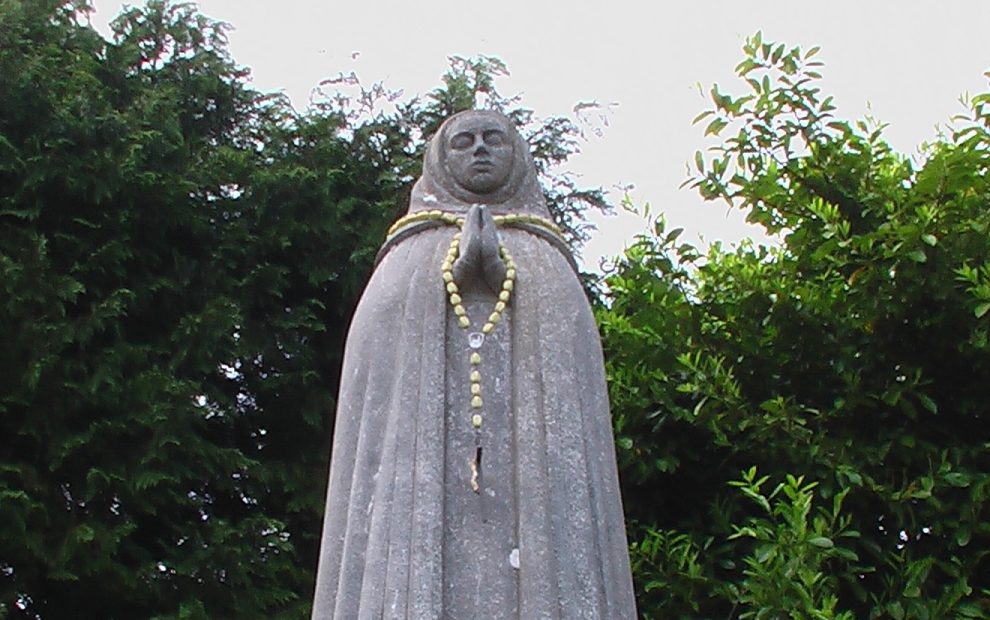Ireland is known as the land of saints and scholars, and for good reason. Ireland boasts a variety of wild and wonderful saints, including a stunning repertoire of women saints from Irish folk history. Yet we mostly hear about St. Patrick (and occasionally, St. Brigid) in the springtime.
To bridge the celebration of Women’s History Month with the church’s attention towards Ireland in March, I’ve devised a list of the wild and wonderful women saints of Ireland. Whether you’re hoping to grow in your understanding of the island or add more saints to your spiritual rolodex, read on.
An important note: Some of these saints were removed from the Roman Calendar during the Second Vatican Council. Their feast days were no longer listed as memorials for daily Mass or divine office but could still be celebrated privately.
St. Íte of Killeedy
St. Íte (also known as Íde, Ita, Ida, or Ides) was an Irish nun who lived in the 6th century. She is considered the second most significant woman saint in Ireland after Brigid, heralded as the “foster mother of the saints of Erin [Ireland].”
St. Íte was borne in Co. Waterford, then called Deirdre, born from royal lineage. In her youth, Íte was visited by an angel in a dream who gifted her three precious stones. In another visitation, the angel revealed that these stones represented the gifts of the Trinity that would come to her throughout her life. She thus refused marriage and instead pursued the religious life and consecrated virginity.
Íte was known for her virtuosity in Irish and Christian society. At the age of 16, Íte founded a religious community in Killeedy (formerly known as Cluain Credhail) in Co. Limerick, where she resided for the rest of her life. As legend has it, Íte was led to Killeedy by three heavenly lights visible across mountainscapes in the region.
At the monastery she founded, she educated many young people. Her provenance was known throughout Ireland, and other saints—such as St. Brendan the navigator—visited her and held her counsel in high esteem. She was known for her spiritual discernment, the gift of prophecy, and her austerity.
St. Íte is celebrated on January 15, and she is sought as an intercessor for pregnancy and eye illnesses. Her life reminds us to look around us and bask in the wonder of our world and to be open to the revelations God has for us. St. Íte’s life also illustrates the holy work of educators, encouraging us to support teachers amidst educational restrictions and rising anti-intellectualism movements.
St. Gobnait of Ballyvourney
St. Gobnait is a saint shrouded in great mystery, as her life story was not recorded during the medieval period. Versions of her story from the 12th/13th century sources such as the Vita Sancti Abbani (Latin Life) and the later Betha Abáin (Irish Life) suggest that Gobnait lived during the 6th century.
As recorded in later centuries, the story of Gobnait is as follows. She was born in Co. Clare in the West of Ireland. Following a family fued, she left for Inisheer (in Irish, Inis Oírr), the smallest of the three Aran Islands. Here, she founded a church. An angel appeared to Gobnait and urged her to journey to the mainland for a “port a h-aiséirí” (or a place for her to await her resurrection), which would be marked by the presence of nine white deer.
Gobnait’s journey was long and winding, and her stops along the way are now populated with holy wells and churches dedicated to her. She ended her journey in Ballvourney, where she met the foretold nine white deer.
St. Gobnait established monastic communities in Ireland, first in Inisheer and another at Ballyvourney in Co. Cork, a key Irish-speaking (Gaeltacht) region of Ireland. She was renowned for caring for the poor and sick. As such, St. Gobnait is of great importance to the Gaeltacht regions.
St. Gobnait is typically associated with bees—a great honor, given that the Celtic tradition fevered bees as receptacles for the soul when someone died. Gobnait is understood to have kept her own bees, and numerous folk tales illustrate her harnessing of bees to benefit her community. In one tale, she heals a sick nun with her hive’s honey; in another, she sends bees after invaders attempting to steal cattle; and in another, she turns her bees into soldiers to defend her community. She is also associated with metalworkers, as her name is a derivative of Gabha (meaning smith).
St. Gobnait is honored on February 11. On the Dingle peninsula, residents and pilgrimages visit and honor her monuments. Though a mysterious figure, St. Gobnait’s life inspires an ecological message. Her closeness to bees, for example, calls to mind the need to respect God’s creatures—no matter how big or small. As pollinators, bees play an essential role in local ecosystems, contributing to the bounty of our plates by keeping our local food supplies afloat. St. Gobnait’s proximity to bees indirectly reminds us to respect the balance of our earth—and confront imbalances by human hands.
St. Deirbhile / Dearbhla of Belmullet
St. Deirbhile (also known as Dearbhla or Dervla) is a 6th century Irish saint whose story is fairly dramatic. As folklore has it, she was pursued by an unwanted suitor who sought her hand in marriage. She fled this admirer from her native land in Co. Meath to the Mullet Peninsula in Co. Mayo in the West of Ireland. Yet his admiration was unceasing. When she asked her admirer why he desired her, he attributed his attraction to her eyes. Hearing this, Deribhile plucked out her eyes. Horrified, her admirer departed.
Shortly after his departure, she washed her eyes in the waters of a nearby well and regained her eyesight. She then established a monastery at the site of her regained sight.
Today, St. Deirbhile’s well in Fallmore (An Fál Mór) in Co. Mayo is alleged to have curative properties for eye problems. There are yearly pilgrimages on August 15 in honor of the eyed saint.
When I think of St. Deirbhile’s story, I am encouraged by her unwavering devotion to herlife path. She refused to let the whims of another dictate her choices—she clearly understood her present and future vocation. We might find that her story encourages us to consider the ways we have failed to “see” our true path in our lives and correct our sight.
St. Muirgen the Mermaid or Lí Ban
Most wild and wonderful, in my mind, is Lí Ban the mermaid—later baptized St. Muirgen. Lí Ban was the daughter of Eochaidh, King of Ulster. Her story, which is recorded in the Martyrology of Donegal, the Annals of the Four Masters, and other sources, illustrates the often-syncretic faith stories of medieval Ireland.
As the folk tale goes, Lí Ban’s village was swallowed in a flood, as was her father’s palace. In desperation, she and her dog dove under the waves and discovered an underwater cave. There she sought refuge, grieving there in the underwater chamber for a year. She was the sole human survivor. In her loneliness, Lí Ban is fabled to have prayed to the Celtic goddess Danu to be turned into a salmon. Instead, she was turned into a mermaid (and her beloved pet becoming a sea otter).
Lí Ban lived as a mermaid for hundreds of years, singing and exploring the seas, until her voice led her to be discovered by monks. (Some stories say it was St. Comgall’s fisherman Béoán who heard her song.) At Comgall and Lí Ban’s meeting, she agreed to be baptized. St. Comgall baptized her Muirgen, which in Irish means “born of the sea.” At the time of her baptism, she died and is fabled to have gone immediately to heaven. Her earthly form was later buried at a nearby monastery.
Her feast day is January 27, and churches throughout Ireland contain medieval inscriptions of this unusual woman saint.
Lí Ban’s story feels weighty in the aftermath of Storm Éowyn, a powerful extratropical cyclone which battered Ireland in mid-January. This record-breaking storm brought great floods and fierce winds that ripped trees from their roots and nearly one-third of Irish homes without power. As environmental disasters like these increase in frequency due to climate change, Lí Ban can be a saint for climate grief and commiseration. She can also remind us that after we mourn in our “caves,” we must dress the wounds of our world. Holy wisdom can help us in this task.
St. Cera or Kilkeary
St. Cera (also known as Ciara, Keira, Kiara, and even Céire in the Irish monologies) was born in the middle of the 6th century and lived through the 7th century. She descended from the royal race of Conor, King of Ireland. She is alleged to have hailed from Co. Tipperary.
St. Cera was known for her miracles. In one story, her committed prayers extinguished a fire that broken out in the region of Muscraidhe Thire. She was encouraged to establish a convent which she named Cill Cera/Ceire. As her virtuous reputation spread throughout the land, St. Cera found that her convent grew expeditiously. So, she sought to establish a second convent. She found a suitable site at a place called Tech Telle (now Tehelly). After a few years here, she returned to Kilkeary.
St. Cera is fabled to have lived to over 100 years old. As someone who (technically) shares her namesake, I hope to attain her holiness and longevity.
She is remembered on January 5 (her alleged birthday) and October 16 (a day commemorated to her).
St. Cera’s life encourages us to pray—a simple task that has powerful impacts. When we are worn down by sorrows in the world, prayer can nourish our connections to those harmed and wronged by establishing the basis for solidaristic action. Prayer for loved ones and strangers can nurture our hearts even amidst great overwhelm. To commit to our neighbors near and fear in a culture of indifference is not only good—it is miraculous.
The stories of these Irish women saints are admittedly shrouded in uncertainty. Yet the mysteries surrounding these women remind us to draw near to the mystery of God, and see what might be revealed to us in our wild and wonderful faith.
Image: Wikimedia Commons/John Staats, Statue of St. Gobnait












Add comment